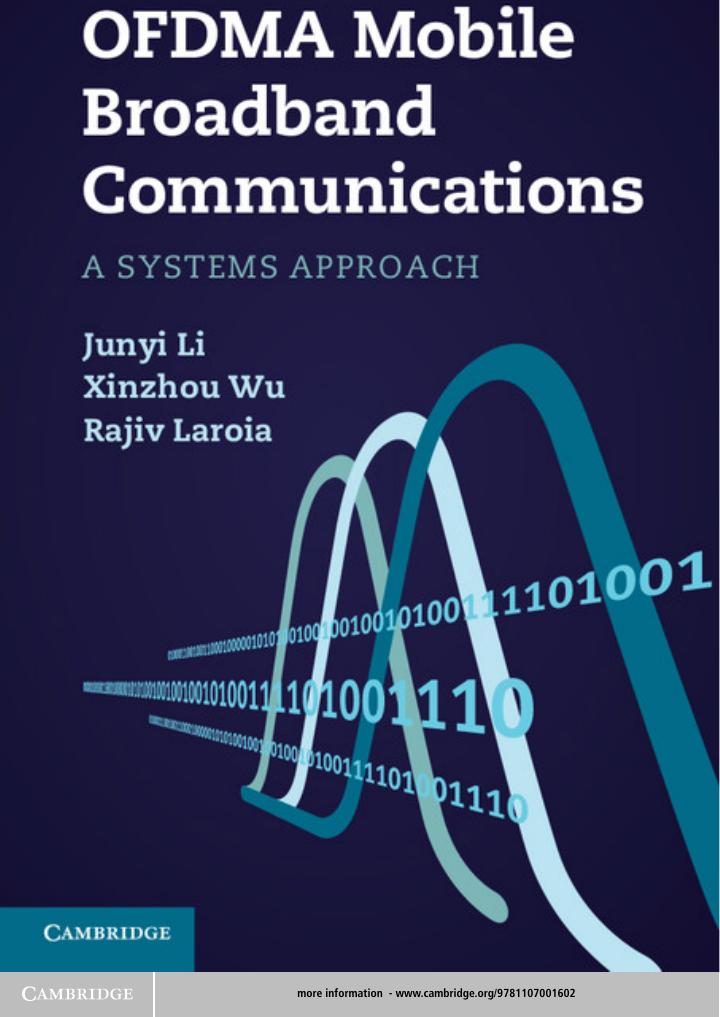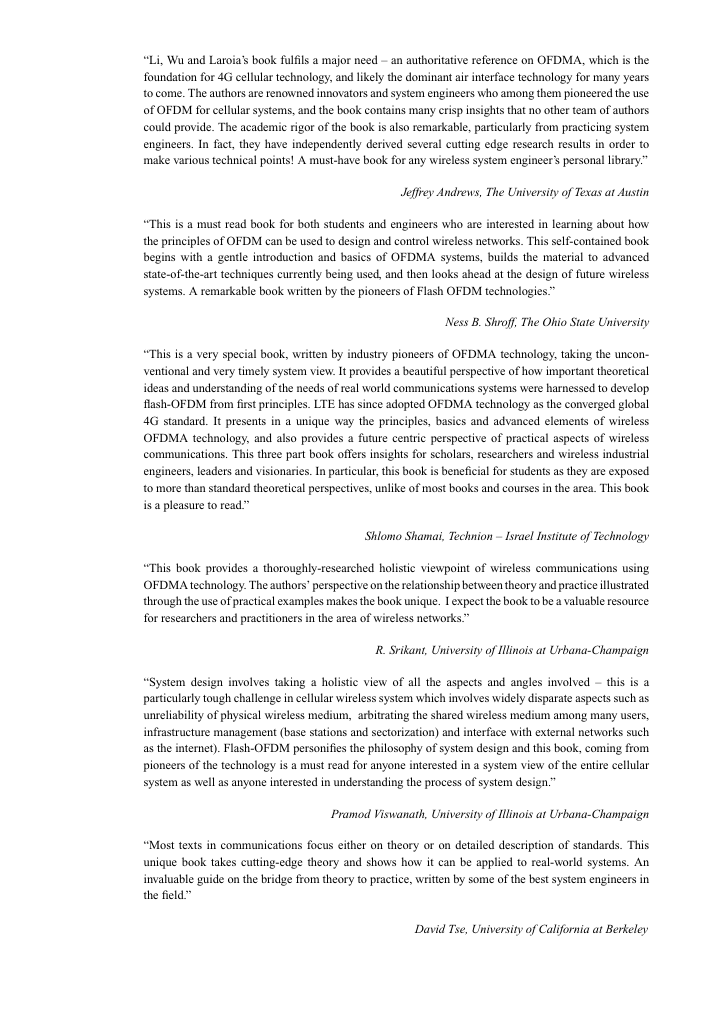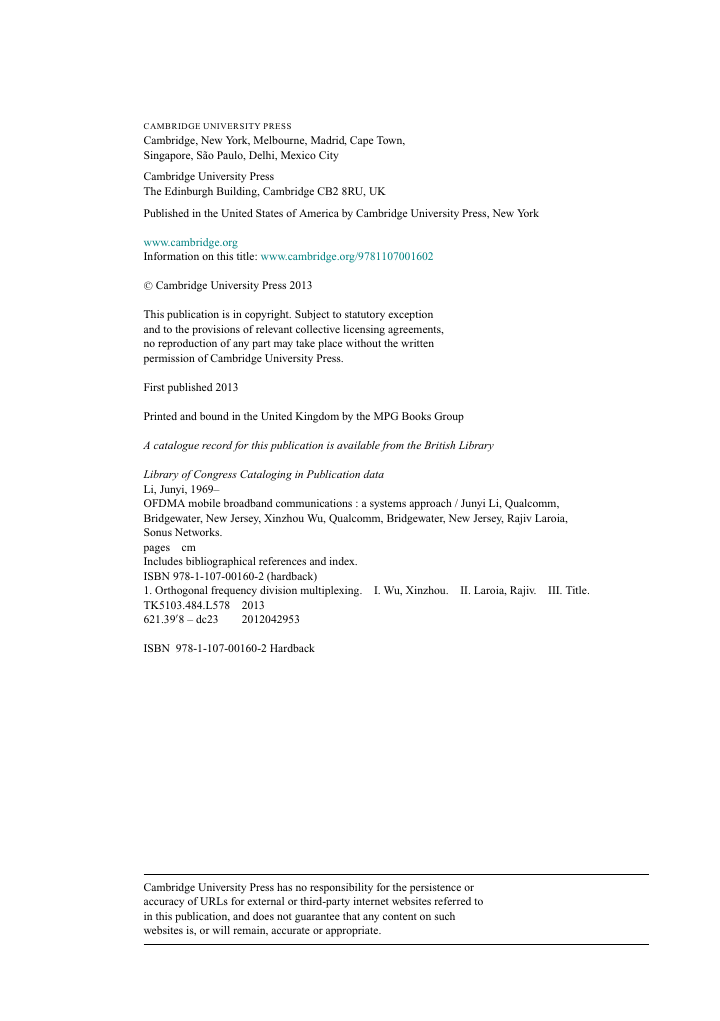Contents
Foreword
Robert Calderbank
Preface
Why we wrote this book
Who will benefit from this book?
Acknowledgments
Notation
Variables
Functions
Abbreviations
General
LTE-specific
1 Introduction
1.1 Evolution towards mobile broadband communications
1.2 System design principles of wireless communications
1.3 Why OFDMA for mobile broadband?
1.4 Systems approach and outline of the book
2 Elements of OFDMA
2.1 OFDM
2.1.1 Tone signals
2.1.2 Cyclic prefix
2.1.3 Time-frequency resource
2.1.4 Block signal processing
2.2 From OFDM to OFDMA
2.2.1 Basic principles
2.2.2 Comparison: OFDMA, CDMA, and FDMA
2.2.3 Inter-cell interference averaging: OFDMA versus CDMA
2.2.4 Tone hopping: averaging versus peaking
2.2.5 Time-frequency synchronization and control
2.2.6 Block signal processing
2.3 Peak-to-average power ratio and SC-FDMA
2.3.1 PAPR problem
2.3.2 PAPR of OFDMA
2.3.3 SC-FDMA and PAPR reduction
2.3.4 Frequency domain equalization at the SC-FDMA receiver
2.3.5 System aspects of SC-FDMA
2.4 Real-world impairments
2.4.1 Carrier frequency offset and Doppler effect
2.4.2 Arrival time beyond the cyclic prefix
2.4.3 Sampling rate mismatch
Phase noise
2.4.4 I/Q imbalance
2.4.5 Power amplifier nonlinear distortion
2.5 Cross interference and self-noise models
2.5.1 Cross interference and self-noise due to ICI
2.6 Self-noise due to imperfect channel estimation
2.6.1 Self-noise measurement via null pilot
2.7 Summary of key ideas
3 System design principles
3.1 System benefits of OFDMA
Fading channel mitigation and exploitation
3.2.1 Fading mitigation
3.2.2 Fading exploitation
3.2.3 Mitigation or exploitation?
3.3 Intra-cell user multiplexing
3.4 Inter-cell interference management
3.4.1 Interference averaging and active control
3.4.2 Universal versus fractional frequency reuse
3.5 Multiple antenna techniques
3.5.1 System benefits
3.5.2 OFDMA advantages
3.6 Scheduling
3.7 Network architecture and airlink support
3.7.1 Unplanned deployment of base stations
3.7.2 Mobile IP-based handoff
Summary of key ideas: evolution of system design principles
4 Mitigation and exploitation of multipath fading
4.1 Multipath fading channel
4.1.1 Impulse response model
4.1.2 Amplitude statistics
4.1.3 Channel variation in time
4.1.4 Channel variation in frequency
4.1.5 Gaussian-Markov model
4.2 Communications, fading channel: single-user case
4.2.1 Performance penalty due to multipath fading
4.2.2 Mitigation of fading via channel state feedback
4.2.3 Mitigation of fading via diversity
4.2.4 Feedback or diversity
4.3 Communications, fading channel: multiuser case
4.3.1 Fading channel and multiuser diversity
4.3.2 Exploring multiuser diversity in frequency and space
4.3.3 Multiuser or single-user diversity
4.4 Summary of key ideas
5 Intra-cell user multiplexing
5.1 Orthogonal multiplexing
5.1.1 Orthogonal multiplexing in the perfect model
5.1.2 Orthogonal multiplexing in the cross interference model
5.1.3 Orthogonal multiplexing in the self-noise model
5.2 Non-orthogonal multiplexing
5.2.1 Non-orthogonal multiplexing in the perfect model
5.2.2 Non-orthogonal multiplexing in the cross interference and self-noise models
5.2.3 Superposition-by-position coding
5.3 Inter-sector interference management
5.3.1 Sectorization
5.3.2 Synchronized sectors
5.3.3 Users at sector edge
5.4 Summary of key ideas
6 Inter-cell interference management
6.1 Analysis of SIR distributions
6.1.1 Downlink SIR
6.1.2 Uplink SIR
6.2 Uplink power control, SINR assignment, OFDMA
6.2.1 SINR feasibility region
6.2.2 Distributed power control
6.2.3 SINR assignment
6.2.4 Joint bandwidth and SINR assignment
6.2.5 Utility maximization in SINR assignment
6.3 Fractional frequency reuse
6.3.1 A two-cell analysis
6.3.2 Static FFR in a multi-cell scenario
6.3.3 Breathing cells: FFR in the time domain
6.3.4 Adaptive FFR
6.4 Summary of key ideas
7 Use of multiple antennas
7.1 MIMO channel modeling
7.1.1 Linear antenna arrays
7.1.2 Polarized antennas
7.2 SU-MIMO techniques
7.2.1 Channel state information at both transmitter and receiver
7.2.2 Channel state information only at receiver
7.2.3 Multiplexing with polarized antennas
7.3 Multiuser MIMO techniques
7.3.1 Uplink SDMA
7.3.2 Downlink beamforming
7.4 Multi-cell MIMO techniques
7.4.1 Coordinated beamforming
7.4.2 Inter-sector beamforming
7.4.3 Inter-cell interference avoidance with polarized antennas
7.5 Summary of key ideas
8 Scheduling
8.1 Scheduling for infinitely backlogged traffic
8.1.1 Fairness based on utility functions
8.1.2 Gradient-based scheduling schemes
8.2 Scheduling for elastic traffic
8.2.1 Congestion control and scheduling
8.3 Scheduling for inelastic traffic
8.3.1 Throughput optimal scheduling
8.3.2 Tradeoff between queue-awareness and channel-awareness
8.3.3 Admission control
8.4 Multi-class scheduling
8.5 Flow level scheduling
8.6 Signaling for scheduling
8.6.1 Dynamic packet scheduling
8.6.2 Semi-persistent scheduling
8.6.3 MAC state scheduling
8.7 Summary of key ideas
9 Handoff in IP-based network architecture
9.1 IP-based cellular network architecture
9.1.1 Motivation for IP-based cellular network architecture
9.1.2 Description of IP-based cellular networks
9.2 Soft handoff in CDMA
9.3 Make-before-break handoff in OFDMA
9.3.1 Parallel independent links to multiple base stations
9.3.2 Mobile IP-based MBB handoff procedure
9.3.3 Uplink macro-diversity
9.3.4 Downlink macro-diversity
9.3.5 MBB handoff in an FFR or multi-carrier scenario
9.4 Break-before-make handoff in OFDMA
9.4.1 BBM handoff in an FFR or multi-carrier scenario
9.4.2 Expedited BBM handoff
9.5 Handoff initiation
9.5.1 The universal frequency reuse case
9.5.2 The non-universal frequency reuse cases
9.6 Mobile-controlled vs network-controlled
9.7 Summary of key ideas
10 Beyond conventional cellular frameworks
10.1 Heterogeneous topology
10.1.1 Relays
10.1.2 Femtocells
10.1.3 Device-to-device communications
10.2 Cooperative communication
10.2.1 User cooperation
10.2.2 Network cooperation
10.3 Cognitive radio
10.3.1 Spectrum sensing
10.3.2 Spectrum sharing
10.4 Summary of key ideas
Appendix A: Overview of system operations
A.1 Cell search, synchronization, and identification
A.2 Link establishment
A.3 Traffic control and transmission
A.4 Sleep state
A.5 Handoff
Appendix B: OFDM point-to-point communications
B.1 Signal-presence detection
B.2 Synchronization
B.3 Channel estimation
B.4 Error correction
Appendix C: Brief review of channel capacity
C.1 AWGN channel
C.2 Flat fading channel
C.2.1 Channel side information only at receiver
C.2.2 Channel side information at both receiver and transmitter
C.3 Frequency selective fading channel
C.4 Multiuser capacity
References
Index
















 2023年江西萍乡中考道德与法治真题及答案.doc
2023年江西萍乡中考道德与法治真题及答案.doc 2012年重庆南川中考生物真题及答案.doc
2012年重庆南川中考生物真题及答案.doc 2013年江西师范大学地理学综合及文艺理论基础考研真题.doc
2013年江西师范大学地理学综合及文艺理论基础考研真题.doc 2020年四川甘孜小升初语文真题及答案I卷.doc
2020年四川甘孜小升初语文真题及答案I卷.doc 2020年注册岩土工程师专业基础考试真题及答案.doc
2020年注册岩土工程师专业基础考试真题及答案.doc 2023-2024学年福建省厦门市九年级上学期数学月考试题及答案.doc
2023-2024学年福建省厦门市九年级上学期数学月考试题及答案.doc 2021-2022学年辽宁省沈阳市大东区九年级上学期语文期末试题及答案.doc
2021-2022学年辽宁省沈阳市大东区九年级上学期语文期末试题及答案.doc 2022-2023学年北京东城区初三第一学期物理期末试卷及答案.doc
2022-2023学年北京东城区初三第一学期物理期末试卷及答案.doc 2018上半年江西教师资格初中地理学科知识与教学能力真题及答案.doc
2018上半年江西教师资格初中地理学科知识与教学能力真题及答案.doc 2012年河北国家公务员申论考试真题及答案-省级.doc
2012年河北国家公务员申论考试真题及答案-省级.doc 2020-2021学年江苏省扬州市江都区邵樊片九年级上学期数学第一次质量检测试题及答案.doc
2020-2021学年江苏省扬州市江都区邵樊片九年级上学期数学第一次质量检测试题及答案.doc 2022下半年黑龙江教师资格证中学综合素质真题及答案.doc
2022下半年黑龙江教师资格证中学综合素质真题及答案.doc